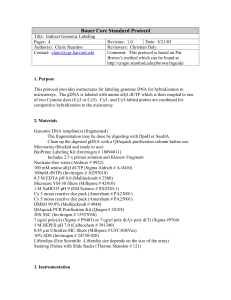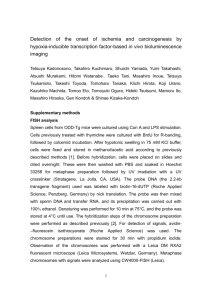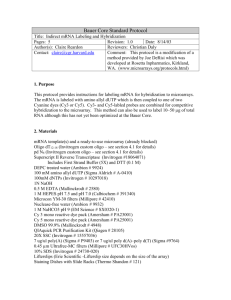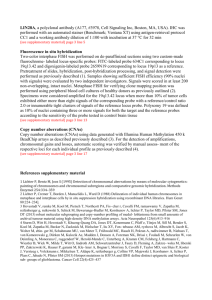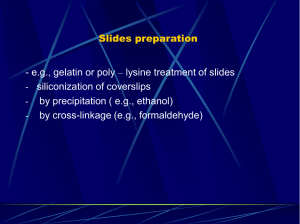Schaus_RT-dUTP
advertisement
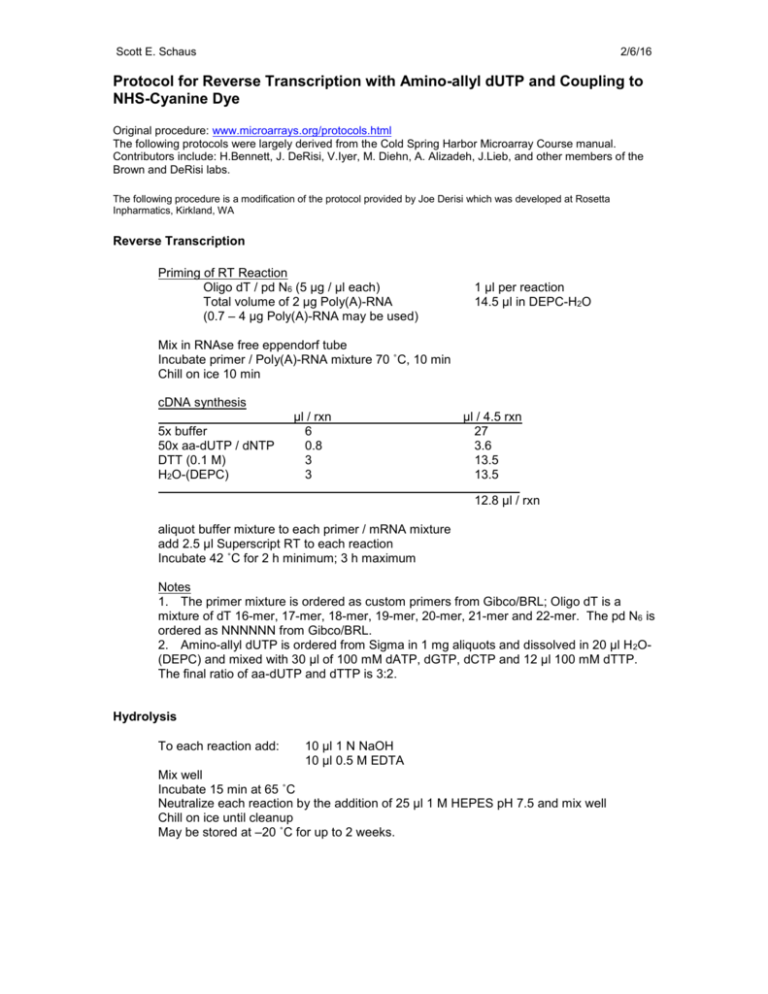
Scott E. Schaus 2/6/16 Protocol for Reverse Transcription with Amino-allyl dUTP and Coupling to NHS-Cyanine Dye Original procedure: www.microarrays.org/protocols.html The following protocols were largely derived from the Cold Spring Harbor Microarray Course manual. Contributors include: H.Bennett, J. DeRisi, V.Iyer, M. Diehn, A. Alizadeh, J.Lieb, and other members of the Brown and DeRisi labs. The following procedure is a modification of the protocol provided by Joe Derisi which was developed at Rosetta Inpharmatics, Kirkland, WA Reverse Transcription Priming of RT Reaction Oligo dT / pd N6 (5 µg / µl each) Total volume of 2 µg Poly(A)-RNA (0.7 – 4 µg Poly(A)-RNA may be used) 1 µl per reaction 14.5 µl in DEPC-H2O Mix in RNAse free eppendorf tube Incubate primer / Poly(A)-RNA mixture 70 ˚C, 10 min Chill on ice 10 min cDNA synthesis 5x buffer 50x aa-dUTP / dNTP DTT (0.1 M) H2O-(DEPC) µl / rxn 6 0.8 3 3 µl / 4.5 rxn 27 3.6 13.5 13.5 12.8 µl / rxn aliquot buffer mixture to each primer / mRNA mixture add 2.5 µl Superscript RT to each reaction Incubate 42 ˚C for 2 h minimum; 3 h maximum Notes 1. The primer mixture is ordered as custom primers from Gibco/BRL; Oligo dT is a mixture of dT 16-mer, 17-mer, 18-mer, 19-mer, 20-mer, 21-mer and 22-mer. The pd N6 is ordered as NNNNNN from Gibco/BRL. 2. Amino-allyl dUTP is ordered from Sigma in 1 mg aliquots and dissolved in 20 µl H 2O(DEPC) and mixed with 30 µl of 100 mM dATP, dGTP, dCTP and 12 µl 100 mM dTTP. The final ratio of aa-dUTP and dTTP is 3:2. Hydrolysis To each reaction add: 10 µl 1 N NaOH 10 µl 0.5 M EDTA Mix well Incubate 15 min at 65 ˚C Neutralize each reaction by the addition of 25 µl 1 M HEPES pH 7.5 and mix well Chill on ice until cleanup May be stored at –20 ˚C for up to 2 weeks. Scott E. Schaus 2/6/16 Cleanup The transcipts obtained from the reverse transcription reaction must be purified and all of the Tris removed before coupling to the NHS-cyanine dye. Label each microcon-30 filter and weigh each filter to the mg (usually 635 mg) Dilute each neutralized reaction to 500 µl with nuclease-free water (Ambion) Add solution to tarred microcon-30 Spin 12000 rpm (10000 xg) for 9 min Remove flow-thru Add 470 µl nuclease-free water and spin 10000 xg 12 min Remove flow-thru and repeat rinse Spin microcon until weight difference is 18 mg (18 µl of solution remains in filter) Collect at 4500 rcf for 5 min The final volume collected should be 10 – 13 µl (the filter retains 5 – 7 µl) Coupling The amine of the amino-allyl uracil must be free-based before coupling to the N-hydroxy succinamide ester of the cyanine dye To the 10 µl of purified probe, add 1 µl of 1 M NaHCO3 pH 9, the final concentration should be no less than 50 mM NaHCO3. Add the basic solution of probe to an aliquot of NHS cyanine dye Incubate in the dark for 1.25 h at rt Note The NHS-ester cyanine 3 and cyanine 5 dyes are purchased from Amersham as the protein labeling dye pack. In each pack, there are 5 vials of dye aliquots. Each vial must be aliquoted into 10 portions. The vial is dissolved in 20 µl DMSO (HPLC grade) and aliquoted into 10 DNAse-free eppendorf tubes. The aliquots are then concentrated on a Speed-Vac under low heat. The dye aliquots are then stored 4 ˚C until use. Purification The probes are purified using Qiagen PCR Purification kit Individually purify each Cy3 and Cy5 probe Add 70 µl H2O to each labeling reaction Add 500 µl PB buffer Apply to Qiaquick column and spin 13000 rpm for 45 sec Aspirate flow-thru Add 700 µl PE buffer and spin 45 sec Aspirate flow-thru and repeat Aspirate flow-thru and spin 1 min 14000 rpm to dry column Transfer to DNAse-free eppendorf tube Add 30 µl EB buffer to filter and allow to stand 1 min rt Spin 1 min 14000 rpm Repeat elution step with another 30 µl EB buffer Label and tare a microcon 30 filter Combine the Cy3 and Cy5 probe for hybridization on filter Spin microcon 30 filter 3.5 min 12000 rpm Weigh microcon and continue to concentrate until 27 mg remain (20 - 22 µl recovery) Collect probe in clean eppendorf tube 4500 rcf, 5 min Scott E. Schaus 2/6/16 Hybridization Preparation To the concentrated probe (20 - 22 µl) add: 3 µl 20X SSC 1.5 µl poly(A) (10 µg / µl) 0.48 µl 1 M HEPES pH 7.0 Wet Millipore 0.45 µm filter with 10 µl H2O Spin 12000 rpm 1 min Aspirate flow-thru Apply probe to filter as a drop Spin 12000 rpm 1 min Remove filter Add 0.45 µl 10% SDS Set up slide in Telechem hybridization chamber Clean Lifterslip with EtOH and Kimwipes Place Lifterslip on the array being sure the white strips are down on the glass Hybridization Heat probe 2 min 100 ˚C Allow probe to cool 10 min rt on bench top Probe volume to be applied should be 23 µl Slowly inject probe at one corner of the lifter slip and continue to apply the probe to the corners being sure not to leave any air bubbles under the lifter slip. Add 40 µl 3X SSC to each of the wells of the hybridization chamber Seal hybridization chamber and place in 60 ˚C water bath, cautious to keep chamber level during hybridization. Allow hybridization to go 12 – 15 h, 60 ˚C
